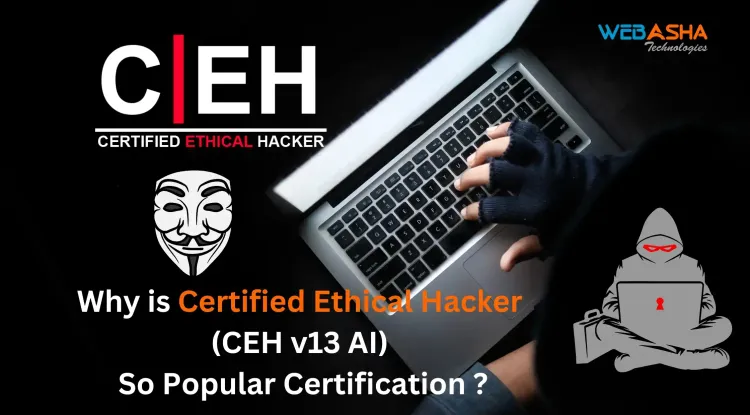Can BlackEye Be Used for Ethical Hacking? Exploring the Role of Phishing Simulations in Penetration Testing
BlackEye phishing can be utilized in ethical hacking, particularly as part of social engineering tests to simulate phishing attacks. It provides valuable insights into vulnerabilities within organizations' security systems and helps evaluate their preparedness against phishing. However, it must always be used ethically and with permission. Ethical hackers use phishing simulations, like BlackEye, to improve employee awareness, enhance security measures, and test the effectiveness of security protocols. However, its scope is limited to phishing and doesn’t cover all areas of penetration testing.

Table of Contents
- Introduction
- What is BlackEye?
- How Ethical Hacking Works
- Can BlackEye Be Used for Ethical Hacking?
- Benefits of Using Phishing Simulations in Ethical Hacking
- Limitations of Using BlackEye in Ethical Hacking
- Conclusion
- FAQ's
Introduction
In the cybersecurity world, ethical hacking plays a crucial role in identifying vulnerabilities before malicious hackers can exploit them. Ethical hackers, also known as penetration testers, use various tools and techniques to perform simulated cyberattacks to strengthen security systems. One such tool that has gained attention is BlackEye, a phishing toolkit used for creating fake login pages to trick users into submitting their personal data. While BlackEye is often associated with malicious intent, the question arises: Can BlackEye be used for ethical hacking?
In this blog, we will dive into how BlackEye works, how ethical hackers use similar tools, and whether BlackEye has a place in ethical hacking engagements.
What is BlackEye?
BlackEye is a phishing toolkit designed to replicate the login pages of popular websites, like Facebook, Gmail, and others, to steal login credentials when users unknowingly enter them. The attacker usually sends a malicious link to the victim, often disguised as a legitimate request (e.g., resetting a password or updating an account), and when the victim clicks on the link, they are redirected to the fake page. Once they input their credentials, the attacker collects them.
BlackEye is one of many tools available in the phishing kit category, which automates the process of creating fake websites to deceive users. While it can be used for malicious purposes, its underlying principle of mimicking real websites is similar to some ethical hacking tactics, specifically in penetration testing engagements.
How Ethical Hacking Works
Ethical hacking, or penetration testing, involves a security professional who is hired by an organization to simulate attacks on its systems in order to find vulnerabilities. These vulnerabilities are then reported back to the organization to help them patch the holes before malicious hackers can exploit them.
Some of the common tools ethical hackers use include:
- Nmap: For scanning networks.
- BurpSuite: For web application testing.
- Metasploit: For exploiting known vulnerabilities.
- Wireshark: For network analysis.
- Social Engineering Tools (SET): For simulating phishing attacks, similar to BlackEye.
While tools like BlackEye are generally considered malicious when used by attackers, tools used in ethical hacking often have the same objectives: exposing weaknesses in a system before they can be exploited by real-world attackers.
Can BlackEye Be Used for Ethical Hacking?
The Ethics of Using BlackEye in Penetration Testing
The use of BlackEye in ethical hacking depends on the consent and the context. In ethical hacking, all activities must be authorized by the organization that owns the system. This is the key difference between ethical hacking and malicious hacking.
In penetration testing engagements, ethical hackers are allowed to carry out simulated attacks to identify vulnerabilities. If the goal is to assess the organization's defense against phishing, then a tool like BlackEye could be used—but only with the organization’s explicit permission. However, without such consent, using BlackEye to launch phishing attacks is considered illegal and unethical.
Thus, BlackEye can be used as part of a social engineering attack simulation within an authorized penetration test, helping organizations to understand how vulnerable their employees or systems are to phishing.
Using Phishing for Security Testing
Phishing simulations are an important part of social engineering testing in penetration testing. In fact, phishing is one of the most common ways malicious actors gain access to sensitive data, making it a critical component of security assessments.
By using a phishing kit (like BlackEye), ethical hackers can simulate the process of how attackers might gain access to sensitive credentials via social engineering tactics. This allows the organization to:
- Test employee awareness: Are employees able to recognize phishing attempts?
- Evaluate security measures: Does the organization have technical defenses against phishing (e.g., anti-phishing software)?
- Measure the impact: What would happen if a real phishing attack were successful?
Ethical Considerations
Using BlackEye, or any phishing tool, should always be done ethically and legally. Penetration testers must always work within the bounds of a contract or authorization from the organization. It is essential to inform and gain permission from the organization before initiating any form of phishing simulation. Unauthorized use of phishing kits, including BlackEye, without proper consent is illegal and punishable by law.
Benefits of Using Phishing Simulations in Ethical Hacking
Phishing simulations, like those that could be done using BlackEye (under ethical conditions), have several advantages for organizations:
1. Improved Awareness
Phishing is one of the most effective attack methods because it preys on human psychology. By testing employees with simulated phishing campaigns, organizations can raise awareness about the dangers of phishing and train employees to recognize suspicious emails, links, or websites.
2. Enhanced Security Posture
By simulating phishing attacks, organizations can identify weak spots in their security infrastructure. This helps them implement better security controls, improve email filtering systems, and adopt additional multi-factor authentication.
3. Realistic Test Scenarios
Simulating real-world phishing tactics provides organizations with a realistic assessment of how prepared they are for an actual attack. This allows security teams to gauge the effectiveness of their training and whether employees are adhering to security best practices.
Limitations of Using BlackEye in Ethical Hacking
While BlackEye may be useful for testing phishing defenses, there are several limitations to consider:
1. Legal and Ethical Boundaries
As discussed, using BlackEye for phishing without permission is illegal. Ethical hackers must have clear, written authorization before attempting any phishing simulation.
2. Limited Scope
BlackEye is limited to phishing attacks targeting user credentials. However, ethical hackers typically perform broader security assessments that also include network security, vulnerability testing, and penetration testing of web applications and systems.
3. No Full Coverage
Phishing is just one attack vector, and while it is important, ethical hacking encompasses a wide range of attack simulations that go beyond phishing. BlackEye would not address vulnerabilities in areas such as network security, system exploitation, or application vulnerabilities.
Conclusion
In conclusion, BlackEye phishing can be used for ethical hacking, but only within authorized penetration testing engagements. It can serve as a powerful tool for social engineering simulations to assess how susceptible an organization is to phishing attacks. However, its use must always be ethically sound, conducted under a controlled, authorized setting, and with proper consent.
Ethical hacking is about strengthening security, and tools like BlackEye can help identify critical vulnerabilities. With the right approach, ethical hackers can use BlackEye as part of their toolkit to improve cybersecurity measures and help organizations build robust defenses against real-world attacks.
FAQ's
What is BlackEye phishing?
BlackEye phishing is a tool used to create fake login pages for popular websites, designed to deceive users into entering their personal credentials.
How does BlackEye phishing work?
BlackEye works by mimicking the login pages of popular websites like Facebook, Gmail, etc. Attackers send a malicious link to victims, and when they click on it, they are directed to the fake page, where their credentials are collected.
Is BlackEye phishing a legal tool?
BlackEye is legal only if used in an authorized penetration testing scenario with the explicit permission of the organization being tested. Unauthorized use is illegal and unethical.
Can BlackEye be used in ethical hacking?
Yes, BlackEye can be used for ethical hacking purposes as part of a phishing simulation in an authorized penetration test.
What are phishing simulations in ethical hacking?
Phishing simulations involve creating fake websites or emails to mimic phishing attacks in order to test an organization's security against such threats.
How does BlackEye relate to phishing?
BlackEye is a phishing toolkit that automates the creation of fake login pages for phishing purposes, making it easier for attackers to deceive users into giving away their personal data.
What is the purpose of BlackEye phishing in penetration testing?
The purpose of using BlackEye in penetration testing is to simulate a phishing attack and test how vulnerable an organization's employees or systems are to such tactics.
What ethical considerations must be taken when using BlackEye?
BlackEye should only be used with explicit permission from the organization being tested. It must be part of a legally authorized penetration test or vulnerability assessment.
Is phishing the same as BlackEye phishing?
Phishing is a general tactic used to deceive users into revealing their personal information, while BlackEye phishing is a specific tool designed to automate the creation of fake login pages for this purpose.
Can BlackEye be used for real-world cyberattacks?
Yes, BlackEye can be used by attackers in real-world cyberattacks. However, its use for malicious purposes is illegal.
How can BlackEye help organizations improve security?
By using BlackEye for phishing simulations, organizations can test the effectiveness of their employees’ awareness and their security measures against phishing attacks.
What tools are similar to BlackEye in ethical hacking?
Tools similar to BlackEye include Social Engineering Toolkit (SET), Gophish, and Evilginx2, all of which are used for phishing simulations in penetration testing.
Can BlackEye be used to hack social media accounts?
Yes, BlackEye can be used to replicate login pages of social media platforms, tricking users into entering their credentials, which attackers can then use to access accounts.
Why is phishing considered one of the most common attack methods?
Phishing preys on human psychology, making it easier for attackers to deceive individuals into divulging personal information, such as passwords, without their knowledge.
What role does social engineering play in phishing?
Social engineering in phishing involves manipulating individuals into performing actions (like clicking on malicious links or providing credentials) through psychological tricks.
How can companies defend against phishing attacks like BlackEye?
Companies can defend against phishing by training employees to recognize phishing attempts, implementing anti-phishing software, and using multi-factor authentication.
What are the potential consequences of falling victim to BlackEye phishing?
The consequences of falling victim to BlackEye phishing include identity theft, unauthorized access to accounts, financial loss, and exposure of sensitive personal information.
How can ethical hackers use BlackEye for phishing simulations?
Ethical hackers use BlackEye by creating fake login pages for phishing simulations during penetration tests to assess how well organizations can defend against phishing.
Is BlackEye useful for testing multi-factor authentication (MFA)?
BlackEye can be used to test MFA’s effectiveness against phishing attacks by evaluating whether it provides additional security even when attackers attempt to steal login credentials.
What are the key differences between BlackEye and other phishing tools?
BlackEye is a phishing toolkit with a focus on replicating login pages. Other tools like SET or Evilginx2 may offer additional features, such as advanced social engineering methods or email phishing.
Can BlackEye be detected by antivirus software?
While BlackEye itself might not be flagged by antivirus software, phishing pages it creates could be detected by some anti-phishing technologies, depending on the tactics used.
How long does a BlackEye phishing attack typically last?
The duration of a BlackEye phishing attack can vary, but once an attacker sends out the malicious link, the attack could last until the victim submits their credentials or the phishing page is flagged.
Can BlackEye be used for mobile phishing?
Yes, BlackEye can be adapted to create fake login pages for mobile applications, allowing attackers to target mobile users with phishing links.
What are some signs of a BlackEye phishing attempt?
Signs of BlackEye phishing attempts include unusual login pages, slight misspellings in the URL, requests for personal information, and warnings from web browsers or email clients about unverified sources.
Is there a way to prevent BlackEye phishing?
Preventing BlackEye phishing involves training users to recognize suspicious links, ensuring websites use HTTPS encryption, and implementing email filtering systems to block phishing attempts.
How effective is BlackEye at tricking users?
BlackEye can be highly effective at tricking users, especially when the phishing page closely mimics the legitimate site and is sent in the form of a convincing email or message.
Can BlackEye be used to bypass security software?
BlackEye can bypass some basic security measures, but advanced anti-phishing technologies and multi-factor authentication can help prevent attacks from being successful.
What is the role of cybersecurity awareness in preventing phishing?
Cybersecurity awareness is critical in preventing phishing, as it empowers employees and users to recognize suspicious activity and report phishing attempts before they succeed.
What are the challenges in detecting phishing attacks like BlackEye?
Challenges in detecting BlackEye phishing include its ability to closely replicate legitimate login pages, the use of convincing messages to lure victims, and the constant evolution of phishing tactics.









![Top 10 Famous Ethical Hackers in India [2025]](https://www.webasha.com/blog/uploads/images/202501/image_650x434_677d16039e931.webp)


![Top 10 Ethical Hackers in the World [2025]](https://www.webasha.com/blog/uploads/images/202408/image_100x75_66c2f983c207b.webp)

![[2025] Top 100+ VAPT Interview Questions and Answers](https://www.webasha.com/blog/uploads/images/image_100x75_6512b1e4b64f7.jpg)









